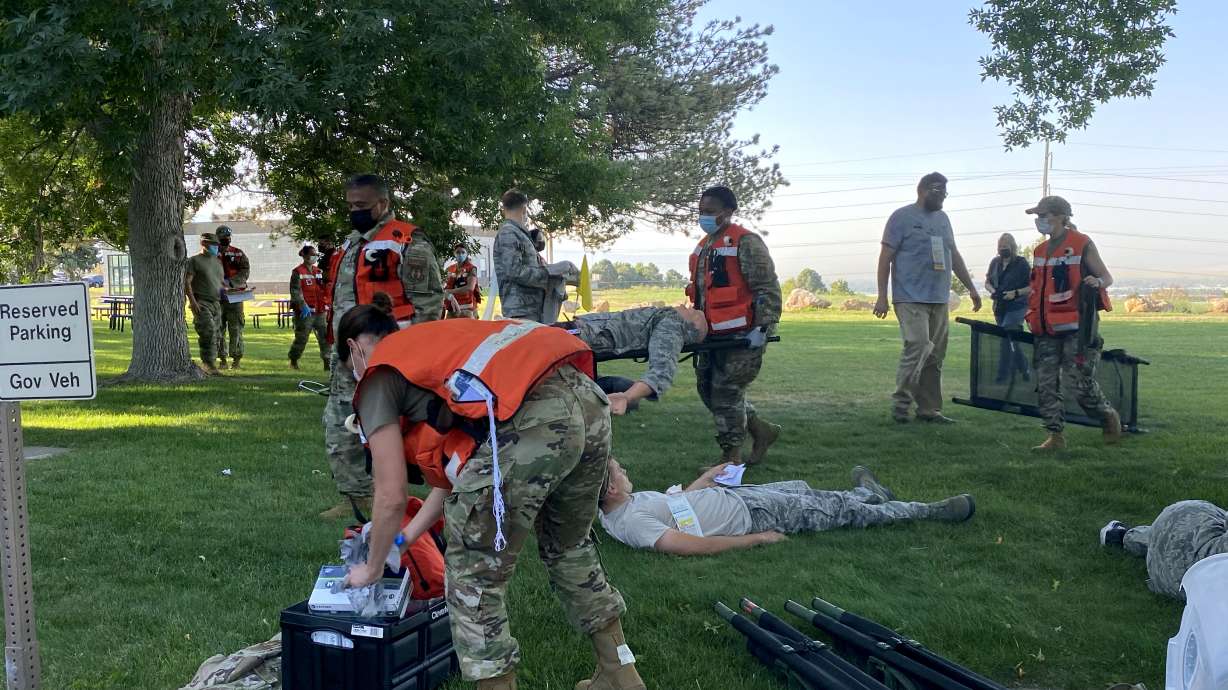Estimated read time: 3-4 minutes
This archived news story is available only for your personal, non-commercial use. Information in the story may be outdated or superseded by additional information. Reading or replaying the story in its archived form does not constitute a republication of the story.
HILL AIR FORCE BASE — Ambulance sirens wailed in the background, occasionally drowned out by the roar of military airplanes passing overhead. Medical and biohazard teams flitted between "injured" patient-actors calling for help, while Hill Air Force Base leadership calmly looked on. It was all part of charade — a full-scale disaster response exercise — on Friday.
It was all set up to depict the aftermath of a biochemical explosion outside one of Hill Air Force Base's buildings. The drill held on Friday was the capstone of a weeklong training called "READY Eagle," provided by a contract company with the U.S. Air Force to standardize training across bases.
Hill Air Force Base leadership said that the event was the first of this size at the Utah base and was meant to fully stress the team's response.
"What we really want to test is our ability to kind of secure a scene, help those folks who are not only injured from an explosion standpoint but from the chemical or biological aspect. We're practicing our decontamination teams, and getting those folks so that we can decon people before we take them into an environment where we can provide further health care," said Col. Lance Nussbaum, the 75th Medical Group's chief of aerospace medicine.

The event had approximately 70 people volunteering in roles ranging from injured patients to panicked civilians.
"We will introduce my medics to all kinds of different casualties. The purpose of it is to educate and then, of course, to stress our system to ensure that my medical airmen are ready to respond in a real-world disaster," explained Col. Tracie Swingle, commander of the 75th Medical Group.
Mass casualty exercises are helpful in gauging airmen's response to disasters and expediting the process, but Swingle added that preparing the airmen extends beyond that.
"A lot of these airmen are 18, 19, 20 years old and have no experiences with a natural disaster or an incident on base — active shooter, for example. And so it's my responsibility to give them the tools that they need to not be fearful when the day happens. So the more we can train and exercise and pause, and understand what our obstacles are, the better prepared my airmen will be," Swingle said.
A sense of calm is important, she emphasized, especially when one of the greatest challenges in a mass casualty event is keeping the surrounding population calm.
"There's a lot of anxiety, there's a lot of fear. So understanding how to not only take care of your patients but to keep the population, the community, calm, that's probably the hardest obstacle. You will see in real life, people are afraid and with that comes a lot of other issues that come with that that take my people away from taking care of the patient," Swingle said.
Nussbaum added that in mass casualty situations, communication is key.
"One of the biggest pieces with any event like this is really communication. Communicating what's going on on the scene, communicating your needs, what you know, how you can get help to other people," he said.

While Friday's event depicted a large-scale biochemical explosion, other mass casualty exercises include a variety of responses and events. Mass casualty trainings are scheduled throughout the year targeting natural disasters, terrorist attacks, an active shooter on base, an aircraft going down or a public health crisis.
But whatever the event may be, Swingle said any airman is driven by the same desire.
"It's all about service. Anybody that wears the military uniform, it's because we want to serve others," Swingle said.
Nussbaum followed Swingle's sentiment, adding that that mission is made possible by the surrounding communities.
"The local support from the community has helped us at Hill Air Force Base really be able to focus on our mission and kind of help defend Americans in that respect," he said, "and so, for us, that community connection, that community support we have, is just, we can't thank you enough from the local community. "










